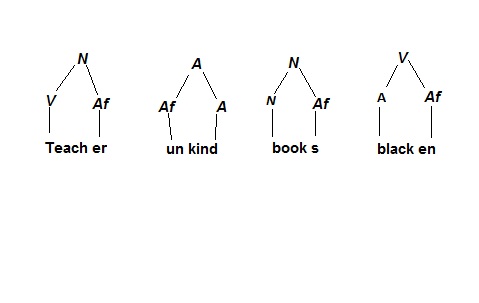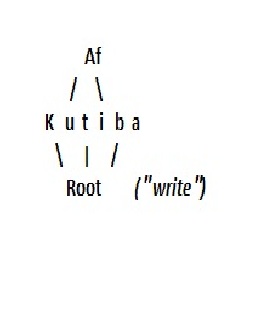ANALYSING WORD STRUCTURE
To identify the internal structure of words, we need not only to identify the component morphemes but also to classify them according to their contribution to the meaning and function of the word
تحليل بنية الكلمة هيكل
لتحديد البنية الداخلية للكلمات، نحن بحاجة ليس فقط تحديد نسمي عناصر الصرف ولكن أيضا تصنيفهم وفقا لمساهمتها في معنى ووظيفة الكلمة.
Roots and affixes: Complex words consist of a root morpheme and one or more affixes.
الجذور واللاحقات:كلمات معقدة تتكون من مرفيم الجذر واحد أو أكثر اللاحقات.
The root is the core of the word that carries the major meaning component. Typically, roots are lexical categories such as N, V, A, or P.
الجذر هو جوهر الكلمة التي يحمل عنصر معنى كبير. عادة، والجذور هي فئات المعجمية مثل N، V، A، أو P.
ملاحظة ذكرها الدكتور في الشرح
ان root are lexical word
root are lexical categories
affixes are not lexical its always bound
_______________________
Below are examples of the internal structure of some words
 اللاحقات ليست معجمية ,وهي دائما ترتبط بـ الفونيم (الصرف)
مثالer
في كلمة
اللاحقات ليست معجمية ,وهي دائما ترتبط بـ الفونيم (الصرف)
مثالer
في كلمة
teach هي اسم noun
ضفنا عليها
er
اصبحت صفة
teach-er
V + er =
N
وفيما يلي أمثلة على الهيكل الداخلي للبعض الكلمات
Affix types: There are 3 types :
A prefix is attached to the front of the base.
Ex. De-activate, re-play, il-lega
البادئة موصولة إلى الجزء الأمامي من القاعدة.
A suffix is attached to the end of a base
. Ex. Faith-ful, govern-ment, hunt-er
الواحق تتصل مع نهاية القاعدة
An infix, which less common, occurs within another morpheme.
والتي أقل شيوعا، ويحدث داخل مرفيم آخر.
تحدث داخل اللواصق
For example, in Tagalog, the language spoken in the Philippines, we find: bili è buy, the past form of which is b-in-ili è bought.
مثال
نجد ان
Tagalog
اللغة المستخدمة في الفلبين
نجد
bili
معناها
buy
, the past form of which is
b-in-ili
معناها
bought
in هنا هي الحرف الماضي التي تضاف للكلمه وتعني انها تحولت للماضي
كما في الانجليزيةed
وايضاً بلغة اخرى
Beware! –ish
in boy-ish-ness is NOT an infix. _________________
Arabic, and other Semitic languages, has interesting illustrations of infixing.
Roots in Arabic are consonantal.
Various combinations of vowels are
added, including in between consonants to mark grammatical contrasts such as
اللغة العربية، ولغات سامية أخرى لديها الاهتمام اللواصق
جذور في اللغة العربية ساكنة, تركيبات مختلفة من أحرف العلة
المضافة، بما في ذلك في ما بين الساكنة علامة نحوية متناقضة مثل*
ملاحظة من الدكتور
there isn't vowels in Arabic root
Kataba => wrote, kutiba => has been written, aktub => I write/am writing.
One way of representing these facts is by assigning vowels to a different tier, level :
طريقة واحدة لتمثل هذه الحقائق عن طريق تعيين أحرف العلة إلى طبقات مختلفة، مستوى:

Problem cases
English morphology is said to be word-based.
Consider the following:
re-do, treat-ment.
Most complex words are like these two.
حالات المشكلة
علم الصرف الإنجليزية تعتبر اساس الكلمة.
مع مراعاة الاتي :
re-do, treat-ment
الكلمات الأكثر تعقيداً مثل هذين المثالين.
Not all languages are like English, Spanish and Japanese, verbal roots are ALWAYS bound and cannot therefore stand alone. Arabic is also like that.
ليس كل اللغات مثل الإنجليزية, والإسبانية واليابانية، وجذور اللفظية تكون دائماً مرتبطة و ولذلك لا يمكن أن تقف وحدها. اللغة العربية أيضا مثل ذلك.
English also has a number of bound roots such as unkempt ( unkempt hair) which does not break into un+kempt .
لديها الإنجليزية أيضا عددا من جذور المربوطة مثل أشعث (أشعث الشعر) التي لا نستطيع فصلها اوكسرها unkempt
____
Other words such as inept were borrowed into English from Latin ineptus (unsuited). Today, this word cannot be broken up into * in-ept.
عبارة أخرى مثل كلمة
inept
جلبت للغة الإنجليزية من
هذه الكلمة لا يمكن تقسيمها
Another class of borrowed words from Latin via French is represented by the following:
receive, conceive, perceive, permit, submit and commit.
وتتمثل فئة أخرى من الكلمات المستعارة من اللغة اللاتينية عن طريق الفرنسية بما يلي:
receive, conceive, perceiv
, permit, submit and commit
Each potential division of the word does not have a meaning of its own.
Re- => 'again' but –ceive => ?.
Consequently, these words cannot be segmented.
كل تفسيم محتمل للكلمة لايمتلك معناً خاص به
كلمة
receive
كلمة لايمكن تجزئتها او فصلها
Re- => 'again' but –ceive =>